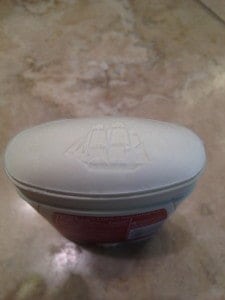Here's a light hearted topic for Lean Thinkers. “Overprocessing” is one of the 8 Types of Waste that we talk about in a Lean context (it comes from Toyota and Taiichi Ohno). One way of describing overprocessing is that it is wasteful to do more than the customer values. It can sometimes be difficult to find examples of this.
 I didn't take a picture, but you can check this out easy enough in a drugstore. A bought a stick of Old Spice “Red Zone” Invisible Solid, as I've been doing for a while. I opened the cap and saw this little Old Spice logo imprinted in the top of the antiperspirant stick. How cute. But also very unnecessary, maybe??
I didn't take a picture, but you can check this out easy enough in a drugstore. A bought a stick of Old Spice “Red Zone” Invisible Solid, as I've been doing for a while. I opened the cap and saw this little Old Spice logo imprinted in the top of the antiperspirant stick. How cute. But also very unnecessary, maybe??
After the very first application of the product, the logo was literally wiped away.
I wonder how much the specialized machine cost, the one that was required to put that little logo on the stick? How often does it break down, stopping production? Does the marketing silo insist that their little logo be there? If so, is the cost of manufacturing that logo paid for by marketing? Would customers be less “brand loyal” without that logo? How many even notice if they're using the product early in the morning in a semi-dark bathroom?
Anyway, I'm convinced it's overprocessing and I'll probably use it as an example of such. Do you agree?
Updated: This has prompted some excellent discussion in the comments. I was probably wrong on this one or should have asked “why?” first.
What do you think? Please scroll down (or click) to post a comment. Or please share the post with your thoughts on LinkedIn – and follow me or connect with me there.
Did you like this post? Make sure you don't miss a post or podcast — Subscribe to get notified about posts via email daily or weekly.
Check out my latest book, The Mistakes That Make Us: Cultivating a Culture of Learning and Innovation:










Mark, you are starting to freak me out man.
We both blog about lean, we live in the same town, attend the same church, and now I learn we use the same deodorant! When will this stop!
Oh, and yes, this is overprocessing in its purest sense (no pun intended). In fact, I have never even noticed this little stamp until you said something!
I’ve seen this before on Degree as well. It does seem to be a waste. I don’t care about it, and like you said, it’s gone in a stroke. To me, it’s the same as having more than one color on a tube of toothpaste. It’s toothpaste, not humanity’s only hope. How many times do the label printers break down? The crates of tubes delayed, etc.?
I vote not overprocessing, but I
assume that the logo is not stamped, but rather cast into the deodorant when the deodorant, in goop form, is poored into the container. To put a logo into the mold equipment is a rather trivial addition for the sake of “brand” and its a one time cost-one time impact on timing, etc.
Great point Andy. Never thought of it like that… but you are probably right. It’s just like an injection molder adding a little logo to the plastic piece. Very easy to do and a one time occurence.
Hate to point out the obvious, but since you identified the logo and the brand – they have probably just received more marketing than they could have ever hoped for paid for with the “overprocessing” ;-) Bill
Bill, you’re onto something. It’s a very insidious “guerrilla” advertising campaign:
1) Build (muda) waste into your product, service, or management system
2) Get Mark to blog about it (the more irritated he is, the better)
3) Profit
I bet Mark’s paid off by Old Spice, Chrysler, Northwest Airlines, National Car Rental, and others.
The NBA and the Lean Blog… they’re FAN-tastic! ;-)
Just kidding, of course!
The logo is there so you can see that it has not been tampered with. It’s to give the customer the relief that their precious armpits won’t be contaminated. Most deodorant (or maybe all) that I’ve seen is in a packaging that can be opened with no tamper-proofing (i.e. exterior wrapper). So, anyone can walk into the drugstore and pop open the tube, but if the logo is still there then you know nothing has wiped it’s surface.
Interesting that everyone assumes this is a pointless step instead of asking the deodorant companies “why?”…..
Jennifer — you’re absolutely right. Shame on me for not asking “why?”
The anti-tampering is a very good reason (although there is also a plastic inner cap that would seem to serve as an indicator).
Thanks for the comments, everyone, serious or joking.
Two reactions to Mark’s Blog. First I can think of lots of examples of overprocessing especially in business processes, like HR, Accounting, Customer Service, Purchasing, Engineering: the complex forms, the focus on precision, gathering information never used, etc. Are all items that rarely add value to customer and have significantly more info than needed even to do the NVA necessary activities. It is when we get cross functional groups of people together to look at the process (kaizen event) do we see so much overprocessing for what it is.
Second point, I want to encourage us to get rid of the thinking about WHO, meaning which department within a company, PAYS for something. It does not matter if marketing or manufacturing pays for something. These types of artificial delineations are inward focused instead of customer focused. Even a discussion of who pays is waste and NVA. It is similar to a discussion of whether a person who works in manufacturing is a direct labor or non direct….it doesn’t matter when evaluated based on providing quality products to customers on time with as little waste as possible utilizing the collective genius of people.
That is my Soapbox!
Jean Cunningham
Author of Real Numbers: Management Accounting in a Lean Organization and Easier, Simpler, Faster: Systems Strategies for Lean IT
[…] my post about overprocessing and logos on deodorant, I was properly taken to task by a blog reader, Jennifer, who asked why we all jumped to […]
It looks like Old Spice has stopped with the imprint of the logo, based on a recent purchase.
Picture
I know it was brand new because the plastic disposable inner cap/seal was on pretty tightly. Maybe that is their new method for ensuring/illustrating that it’s a new, unused stick.
On first blush this may appear to be an example of waste but I think a deeper effort at understanding may be in order. Many companies are attempting to do whatever they can to build brand loyalty and a great first impression from the moment a product is unwrapped. This has made things such as manuals, packaging materials other things that typically didn’t get much of a look in the past become critical marketing tools. Think of the last time you opened an Apple product, much of the way it was packaged may look excessive or wasteful from a strictly lean perspective (my iphone box feels like it is made of wood rather than cardboard) unless you consider first impression and brand loyalty to be value added. My guess is that this deodorant company is simply trying to do their part to get their logo out there. Honestly I am not a user of old spice and didn’t even realize that their logo was a ship until I saw this. I assume the fact that I know that now may be worth something to them.